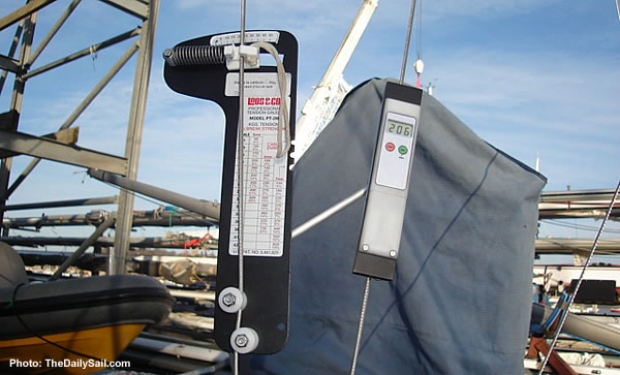Going digital
Wednesday February 21st 2007, Author: Andy Nicholson, Location: United Kingdom
When it comes to electronics, the dinghy and small keelboat world really have had little to shout about compared to what is now available for the leadmine sailor. With electronic analysis on yachts commonly now being handled by computer, tasks such as navigation, weather and performance analysis are regularly undertaken.
Now, however, it may be the turn of the small boater to get some envious glances from the Dubarry-booted hordes: Introducing the RigTune - a prototype digital rig tension gauge. The unit has been designed to measure the loads on 3-7mm diameter standing rigging, very much Loo’s Gauge territory.
Two years ago the specialist yacht electronics company Diverse Yacht Services were approached by the RYA to see if it was possible to put a strain gauge into a device small enough for what was needed for the Olympic classes. The company has extensive experience with load cells for every conceivable application for the Grand Prix racing yacht, but this project was a departure for them.
The Diverse RigTune has since been picked out by Harken UK and they are looking into the possibility of taking the device to the mass market. It will require serious investment to get a finished product produced. The production run needs to big enough so that the end user retail price is in the right ballpark. So it is still early days although feedback so far has been very positive.

In principle, the unit establishes the load in a length of wire or rod by forcing it to deflect by a fixed amount over a fixed length. On the reverse of the bar are three pins and a levered cam. The wire fits onto guide pins at the top and bottom while a lever is brought down to push the wire into contact with the central pin. This then bends the whole bar and the strain gauge within calculates the load in Kgs.
We took the RigTune and a standard Loo’s Gauge and headed out into the yard to apply them to a Laser SB3.
We took base measurements of the V1, D1 and the chicken stay - or caps, shrouds and lowers in dinghy terms - and then adjusted the rigging while taking measurements with both devices. We quickly got the hang of taking a reading with the digital gauge and were showing loads to the nearest 1kg.
Click here for a short video clip (.wmv) of the measurements being taken.
Where the Loo’s gauge wins on ultimate simplicity, the RigTune wins on sheer precision and sensitivity. Putting a turn on the starboard V1 actually brought the two sides equal (257 kg) on the SB3 where the Loo’s was registering ‘between 15 and 16’.
|
|
|
|
|
From Starboard
|
||
|
|
|
Base Port
|
Base Starboard
|
Plus 1
|
Plus 2
|
Plus 3
|
| V1 | Loos |
15
|
15
|
15.5
|
16
|
|
| 4mm | RigTune |
257
|
252
|
257
|
268
|
|
|
|
|
|
|
|
|
|
| D1 | Loos |
13
|
13
|
14
|
15
|
15.5
|
| 4mm | RigTune |
192
|
209
|
228
|
247
|
269
|
|
|
|
|
|
|
|
|
| Chick | Loos |
no read
|
no read
|
~
|
5
|
|
| 3mm | RigTune |
21
|
17
|
~
|
61
|
|


A criticism of the RigTune it is that it is perhaps too sensitive. Adjusting the rig has to be done symmetrically and in order otherwise you will start chasing your tail with the numbers. Simply not returning the bottle screw to exactly the right position will be picked up.
Using the gauge for just an hour or so though one really did start getting a feel for how all three wires affected the entire rig set up. It is an excellent tool for seeing what an extra turn on the D1s does to the V1 tension for example.
Another advantage is to accurately get yourself back to your base setting at the end of the day, or to take an accurate measurement of a setting that felt particularly good. While you wouldn’t use it on the water, it will prove to be valuable device to ensure that all the day's adjustments (and their likely inaccuracies due to the circumstances) are brought back to heel ready for the following day.
For those who take their rig measurement seriously the likely cost of the RigTune is being mooted at between £100 and £150 - considerably more than a standard Loo’s Gauge but perhaps not out of reach.
The RigTune prototype will be on the Harken stand at the Dinghy Sailing Show in the UK on the 3-4 March.









Latest Comments
Add a comment - Members log in